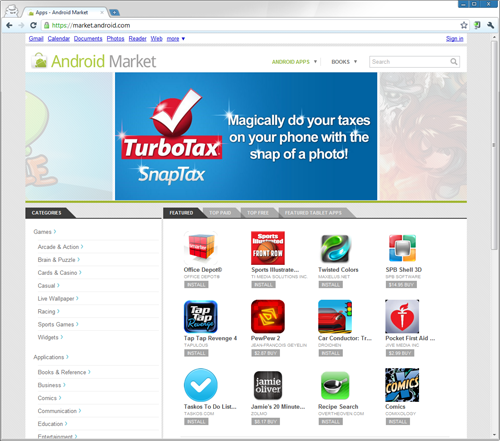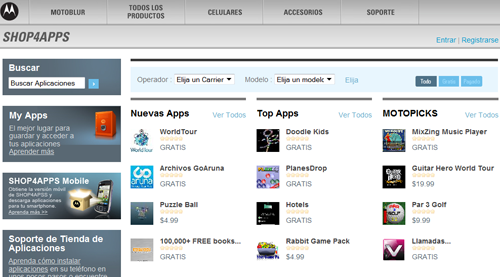developer推荐五大Android应用开发者产品发布渠道
不少Android应用开发者和用户只知有谷歌Android Market这个下载免费和付费应用的平台,却不晓得还有其他更多选项。这些第三方Android应用商店之间的用户覆盖率各不同相同,每一者都有自身存在的价值及其优势。如果开发者推出了一款Android应用程序,可以考虑多种选择,以下是游戏邦编译developer推荐的五个渠道:
谷歌Android Market
谷歌Android Market仍然是最受欢迎的Android应用商店,其产品数量已超过25万种,每日下载量达数千万次,已成为多数Android应用开发者的首选。比起其他Android应用商店和销售平台,Android Market的发展较为成熟,为开发者提供了市场过滤器、漏洞追踪和快速升级等极具吸引力的强大功能。该平台实行三七开的应用抽成原则,即开发者可获得70%的收益,它的准入门槛较低,开发者仅需一次性支付25美元的帐号使用费即可向其投放产品。该应用商店最近还发布了一个网页在线版本,为开发者和用户提供了多项新功能。
注意:Android操作系统限制了手机平台可运行的应用程序,Android手机在默认状态下仅支持运行来自Android Marekt的应用程序。如果用户要安装从其他渠道下载的应用,就必须亲自调整操作系统的设置。而AT&T等特定的移动运营商已移除了这一功能,所以他们的Android设备仅支持访问Android Market的产品。
Handango、GetJar等第三方应用商店
有一些大型的第三方应用商店也针对多个手机平台提供服务,其下载量也相当惊人,其中最为典型的是GetJar和Handango,这二者的发展历史相对悠久,而且可供应大量产品,支持多个手机平台以及多国市场。这类应用商店一般不向开发者征收使用费,但它们的营收模式差异较大。
亚马逊Appstore刚登台不久就赚足大量眼球,因其在数字媒体渠道的成功运营而虏获了无数忠实用户。目前该应用商店提供了大量独家销售产品,并通过“每日限时免费促销”项目吸引了不少用户前来捧场。但与Android Market不同,亚马逊Appstore的功能更为完善,其服务水平更胜一筹。除此之外,该平台还支持用户在下载应用前,通过基于网页的模拟器测试产品运行性能。目前该应用商店与开发者之间也进行三七开分成,但开发者每年需支付99美元的帐号使用费。
移动设备制造商、运营商应用商店
除了上文所述的大型应用商店之外,摩托罗拉(Shop4Apps)、Archos(AppsLib)、LG(LG World)等设备制造商,以及威瑞森((V CAST Apps)等运营商也推出了自己的应用商店。有些应用商店功能也很齐全,但多数仅支持开发者针对特定手机型号或者手机品牌投放产品。运营商应用商店通常会推出补贴性质或者独具特色的应用类型,但其缺点在于开发者经常无法自行控制应用售价,并且在这些平台上做生意要走的流程也比较繁琐。
小型细分市场应用商店
开发者不一定需要考虑大量其他非主流Adnroid应用商店,但要注意的是,虽然这些平台可能仅锁定特定移动设备(游戏邦注:例如平板电脑)或者仅有少数应用程序,但它们也有一些自身长处。有些应用商店会针对开发者或者特定应用产品,在营收分成、市场营销机会等方面为开发者做出更多让步。号称“世界首家成人应用商店”的MiKandi就属于这种细分市场的典型。
自主发布应用程序
当然还可以考虑自主发布应用,这个选项适用于那些不愿与应用商店进行收益分成的开发者。针对特定垂直市场和企业的应用程序、带有强大品牌效应和忠实用户基础的应用、开源应用程序、测试版应用等几类产品,也可以通过这种途径出击市场。这种方式可以让开发者掌握最大的控制权和主动权,但劣势也很明显,那就是缺了中间商这个环节的开发者,只能单兵作战,独揽市场营销、市场调查等琐碎的工作。这方面的代表就是手机游戏发行商Gameloft,该公司有数款Android手机游戏仅限其门户网站提供下载。
结论
开发者在推出应用程序时应该根据自己的实际情况,综合考虑多种发布渠道。虽然Android Market仍是Android生态圈中最瞩目的平台,但并非唯一的选择。GetJar等老牌应用商店以及新晋的亚马逊Appstore同样具有多种功能优势和大量用户基础。一些特殊的小型应用商店,也可以满足特定手机型号、不同用户群体等细分市场的需求。开发者不可将目光局限于同一个平台,而应权衡开发者帐号使用费、营收分成等多个因素后再制定对自己最有利的决策。(本文为游戏邦/gamerboom.com编译,转载请注明来源:游戏邦)
Where to Sell Your Android Killer App
A lot of Android developers and users alike assume that Google’s Android Market is the only place to download free and paid apps for the platform. This is not the case; there are dozens of app stores out there. Some markets have wider or narrower coverage than others, but each has its place, along with benefits and drawbacks that developers need to be aware of. So you’ve developed an Android app — now let’s discuss what your options are for publishing it in today’s market.
Google’s Android Market
Google’s Android Market is still the most popular and well-supported app store for Android apps. With a robust application catalog of Android titles and millions of downloads a day, this is where most developers sell their apps — for good cause. The Android Market has fairly light curation compared to other app stores and platforms, and includes various compelling features for developers, including market filters, easy bug tracking and smooth upgrade support. Currently, developers get 70 percent of the application revenue but they also have to have a paid developer account with a reasonable one-time authentication fee of $25. Recently, a Web store version of the Android Market went live, with many new and compelling features for users and developers alike.
Note: In fact, the Android device operating system restricts the applications that can be installed on an Android device, by default, to only those from this market. In order to enable downloads from other sources, the user must adjust the settings at the operating system level. Certain carriers, such as AT&T, have removed this feature, thus providing the Android Market with exclusive access to their users.
Handango, GetJar and the Other App Superstores
There are a number of big app stores we like to call “app superstores.” These one-stop shops carry apps for multiple mobile platforms and normally sport an application catalog containing tens or hundreds of thousands of app titles with downloads in the hundreds of millions and billions. Amongst the most popular of these are GetJar and Handango. Both have been around a long time, have several hundred thousand apps, support many platforms, and have international reach.
Most of these app superstores have no developer fees, but the revenue models vary greatly. For a pretty comprehensive list of mobile app stores that serve the Android user community, along with app catalog and download data, check out this great spreadsheet on Wikipedia.
The Amazon Appstore opened its virtual doors only a few months ago, but it did so with great fanfare and a pretty amazing track record for digital media distribution with a lot of loyal users.
Right off the bat, they’ve featured exciting exclusive applications, incentivized users to try their store through a popular Free Paid App of the Day program, and made waves with their initial success. Unlike the Android Market, the Amazon Appstore features curation, deals, and a higher level of organization. Additionally, Amazon has a great feature that allows users to test apps before downloading them using a browser-based emulator. Currently, developers get 70 percent of the application revenue, but they also have to have a paid developer account with a fee of $99 a year.
Manufacturer- and Operator-Curated Markets
In addition to the big markets listed, device manufacturers, like Motorola (SHOP4APPS), Archos (AppsLib), LG (LG World), and operators, like Verizon (V CAST Apps), have launched their own app stores. Some of these stores are heavily curated, but they often allow developers to target more specific devices, or device brands. Operator markets often include special application categories for subsidized or featured applications; the downside: developers sometimes have less control over the price for their application and have to go through many more steps to provide an app for download and sale.
Smaller and Specialty Markets
You don’t necessarily want to discount the numerous other app stores that deal in Android applications, either. Although many of these stores are small or carry only apps for certain target devices (e.g. tablets only), they have their perks. Why consider smaller markets? They sometimes offer deals and negotiation opportunities to the right developer for the right app, such as more enticing revenue sharing percentages or free marketing opportunities. One specialty market that there is a store for is the “adult” software market. MiKandi calls itself as the “World’s First App Market for Adults.”
Mobile App Self Publication
Finally, there’s still the self-publication option: selling your apps apart from any market. This is the only option for those who don’t want to pursue revenue-sharing publication modes. This option may be reasonable for certain situations: certain vertical market and enterprise applications, applications with very strong branding and loyal users, open source applications, and beta apps that are not quite ready for primetime. This option also provides the most control over delivery to devices. Only want to target a single device? Need your users to pay for your app on every device they install it on? This may be the only option available if you have strict distribution requirements. The downside, of course, is that by cutting out the middleman, you need to do all the legwork and marketing to reach users yourself. One notable company that primarily uses the self publishing option is Gameloft. Several of their Android titles are only available for download from their website
Conclusion
Developers need to remember that they have many options when it comes to publishing their applications for consumers. Although Google’s Android Market remains the most prominent application store for Android applications, it is certainly not the only publication channel available. Veteran app stores like GetJar have impressive selection of application titles and the recently unveiled Amazon Appstore is already making waves by offering popular exclusive titles to their already impressive user base. Specialty stores, whether they cater to specific device types, or simply different audiences, can help developers reach niche markets. Developers need not restrict themselves to just a single market, but should also weigh the cost of managing various developer accounts with different app stores and consolidating revenue data.(source:developer)











































 闽公网安备35020302001549号
闽公网安备35020302001549号